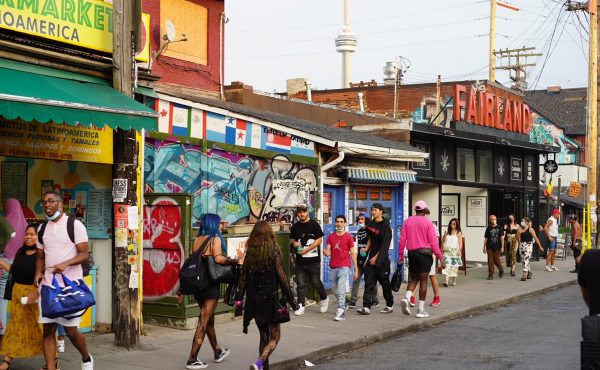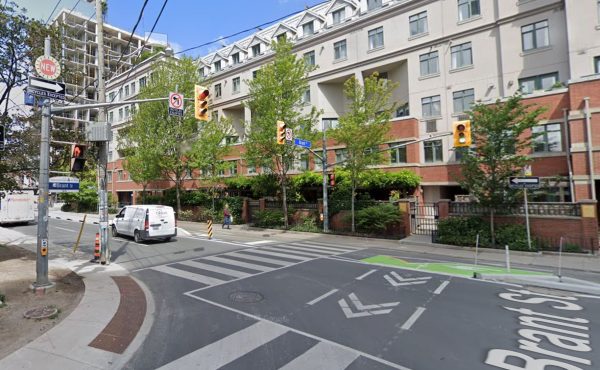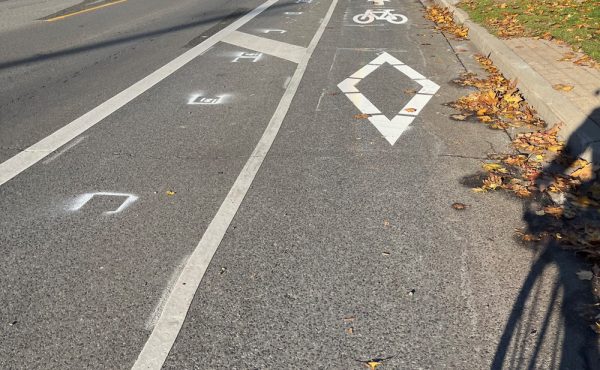
At the start of June, I wrote a post about how Toronto needs to begin the process of creating pedestrian-only zones in the city — we lag behind many large (and dare I say world-class) cities when it comes to giving over a part of the city to our feet. In the mid-1970s, Yonge Street below Bloor was closed off to traffic for the summer (above photo). The project died out after a few years because of a lack of local merchant support, but I suspect the time is just about right for Toronto to *really* start thinking of where and how to implement such a scheme.
I have taken the most popular suggestions from that post’s comment section and included them in this week’s Spacing Poll: Which part of the city should be the first to become a pedestrian-only zone?
CHECK OUT THE OTHER SPACING POLLS:
• Should Toronto implement road tolls on Gardiner and DVP?
• How many bikes have been stolen from you?
photo by Toronto Archives




26 comments
My vote is for Kensington, just makes sense to me, but if there was a part of Queen West I could make pedestrian-priority it would be the first bit – from Yonge to University, at least from say 7am-9pm. Closing the car park entrance and displacing the tour buses elsewhere with only streetcars passing City Hall would be a powerful statement.
I think in terms of sheer pedestrian volume, only Queen St. really makes sense at the moment.
The bulk of retail traffic along Yonge St. is already a pedestrian zone, it’s called called the Eaton Centre.
I would love to have a peds and streetcar-only zone along Queen, and the alleyway behind it could be used as the bike lane.
I’d put my money on Yorkville considering how pedestrianesque it already is and also the redevelopment which will be hitting that area of bloor street (fashion mile) soon enough.
I dislike that the options in this poll are mutually exclusive though.
Using your logic Kev we should also pedestrianize Dundas as it is *WAY* busier with pedestrians that any other part of the city.
Yonge north of Gerrard is bustling as much as Queen West on almost any given day. The towers along Yonge make for lots of peolpe throughout the day.
Rajio >> we can only use 5 options in our polling software. Besides, these were the areas that reader suggested in my previous post so its not like we’re pulling them out of thin air.
There are days I find it difficult to walk along Yonge because of the pedestrian traffic. It’s well used.
I would widen sidewalks and reduce traffic lanes on Yonge. Kensington makes sense as a first pedestrian-only zone (with allowance for deliveries) because cars there make so little sense (a compact area, not a district you would ever need to drive through to get somewhere else).
I was at Woofstock, and was amazed at the crowds. I commented to a friend that I can’t believe any merchant seeing the kind of pedestrian traffic created by closing streets would ever want the street open to cars…
Yonge Street makes the most sense.
Gentrification is not much of an issue on Yonge and the rise in rent would certainly push out some of the low-end retail that still exists on the strip, and bring in more chain stores. This fits in with what the BIA wants and what most of us could swallow. I don’t think we’d like to see the effects of a fully-pedestrianized (and quickly homogenized) Kensington unless it had protection like Camden market does in London England. two streets like Kensington Ave and Augusta would be ideal. Baldwin Village and Mirvish make a lot of sense too. One block areas are easy to do and would neutralize community/merchant backlash.
I like all of the choices in the poll and each one should be included in a master pedestrianization plan of the city’s core. We could do all of these in the next 10 years and transform our downtown is a very positive manner. Add in Little Italy, The Annex, widen sidewalks on Danforth, widen sidewalks along Yonge all the way up to Steeles…. Sidewalk and pedestrian construction are easy and cheap compared to other types of city-building. All of these encourgae us to get out of our homes and interact, even in winter.
Now, also include building sidewalks on every road in the city and then we have a walkable city. And it wouldn’t take much.
Matt: Which part of Dundas has the more pedestrians than Queen? Near Spadina maybe, but I think Queen is generally busier, considering the the sidewalks are four times as wide.
Also, I think what Rajio meant was that he wanted to vote for more than one neighbourhood for a pedestrian only zone. 🙂
I totally agree with the ‘one block only’ idea. It would help to decrease traffic on surrounding streets if done properly, which would further increase the ease of use for pedestrians. Maybe Kensington between Baldwin and that little street with the Moon Bean would be a good spot for this.
Cen >> it centre at Dundas but that ped traffic spreads up almost to College and down to Sullivan. Our office is on Spadina at Sullivan and we get to see the waves of walkers along Spadina. Its dead in comparison from Sullivan down to Queen. I was just saying that picking a street based on the most ped traffic is subjective to where you walk in town. Bloor from Church to Bay and the Financial District are probably the busiest pedestrian parts of the city for certain times of the day. Picking a part of town to pedestrianize first requires a few variables, as Ali rightly points out two comments above.
I think if we want an easy, cheap big win, we start with Cumberland between Avenue and Bellair in Yorkville. (or one of those hybrid ped-car zones where cars have to navigate between strategically placed street furniture) It’s a small but lively strip, there’s the park on the south side which is inundated with people all day long 7 days a week in the nicer months and then the patios etc on the north side. It’s a no-brainer and once everyone sees (hopefully) how successful it is, it will be much easier to use it as an example to roll-out more pedestrian zones across the city.
The sidewalks on Chinatown are very crowded and it would be nice to see the area pedestrian only. I don’t know if this would make sense though because Spadina Ave also has a lot of traffic.
One thing to be wary of is the pedestrianized failure that is Sparks Street in Ottawa – it’s great for about 1.5 hours when government offices let out for lunch, but eerily dead at night, and is mostly due to the lack of mixed-use, mixed-activity zoning in the area.
It’s a good lesson for Toronto to make sure the pedestrianized areas selected aren’t “one industry towns”.
They should be vibrant at all hours of the day, and reliant on the need/desire to walk for a diversity of reasons.
Queen (from University to Spadina, not Yonge) makes more sense than Dundas because Queen West is already a tourism district with mid- to high-end shopping while Chinatown is not and would suffer from rising property values (if pedestrianization worked).
A good deal of Yorkville already has a pedestrian mall. The fact that it is underground is a shame, but there certainly aren’t any cars there.
Yonge Street makes more sense than Bloor as it is not necessary to drive through Yonge Street to cross Toronto (which is much wider than it is tall), but again, the seedy porn shops and strip clubs do not get more traffic than the Fashion District, and the area south of porn land is, as mentioned earlier, a giant pedestrian zone called the Eaton Centre.
Amsterdam has mixed pedestrian/light rail zones and it looks fantastic.
Hey kev — I wasn’t suggesting we turn Dundas pedestrian or that Spadina at Dundas should be ped zoned, but rather the variables for making an area ped-only takes more than just the ped traffic.
Turning Yonge into a ped zone is my preference, especially outside the Eaton’s Centre. That place has turned its back on the city for nearly 30 years, so a ped zone would force its Yonge Street side to address the sidewalk. Currently, it just lets you look into a few shops and a Baton Rouge or whatever steakhouse they have down there. I think Dundas to Bloor would be a great walkway as Yonge doesn’t have *any* on-street parking issues. Yonge-Dundas has already be turned over to mass-consumption so might as well emrabce it and try to make it attractive.
If I recall correctly, the portion of Yonge St. that was turned into a pedestrian mall in the ’70s was south of College.
Queen is most obvious to me — along with a Queen street streetcar ROW. Except that I think the ped mall would only work from university to Spadina (to start.) Ideally from University all the way to Trinity Bellwoods would be spectacular.
Agree with Eric – Sparks is very depressing in the evening, very little going on.
Newsflash re: Ottawa’s Sparks St. ped mall – most of downtown Ottawa is “eerily dead at night” not just Sparks. So let’s not give that excuse any credence.
I just got back from Ottawa. Sparks is often dead at night, a few restaurants and pubs do keep some life, but certainly not enough. However, Byward Market is the centre of the night life, the shopping focus is also on the other side of the canal thanks to the Rideau Centre (Ottawa’s very successful downtown mall).
Ottawa felt very much like a typical mid-sized North American city’s downtown, thanks to the concentration of office towers and not much more, with the busy evening spots on the edges of the core (Byward, Glebe).
Should this pedestrian-only zone be all year or summer only?
If we do institute such a zone, what are the consequences for our other street closures (that usually last for a weekend or so)?
For example, if Yonge Street is closed all the time, can we close down Church St. during Pride Week?
I think the lesson is:
-Don’t choose locations for pedestrianization to create street life – it won’t work.
-Instead, choose locations where thriving, all-day street life *already exists* and can further expand/enhance a district
Pedestrianization isn’t a magic bullet, as Ottawa has found out – and it’s too bad Sparks can’t be salvaged through further diversification of land use.
Oh, if only downtown Ottawa had more of the residential domination issues of downtown Vancouver…
I’d much rather that streets just became more pedestrian friendly than making any area pedestrian only.
The mixed-use streets of Kensingtion are great the way they are. They provide a comfortable, livable, pedestrian-dominated street without the problems that pedestrian-only streets cause.
i pick yonge street, south of bloor to dundas. first of all it wouldnt cost much to accomplish. deliveries could be made to shops through back alleys. the greater tax revenue from increased property value would offset construction costs. similarily, the city could buy a few of massive parking lots that border yonge south of college park and turn it into a square. also, there are more north-south options for cars… bay, uni, jarvis.
Those massive parking lots are already owned by College Park, and slated for imminent redevelopment (well, until the condo towers on Bay are finished)
Yonge Street south of Bloor should be a year-round pedestrian-only area. People always congregate there naturally whenever there is a major event such as sporting victory. It didn’t work in the 70’s because it wasn’t designed properly. People don’t want to hang out on a street with bargain shops, fast food places, porn shops and strip joints. What an idiotic decision that was!
Yonge Street would need to be designed properly with trees, lamps, and stores, shops, restaurants, pubs, banks, offices etc – places that people use during the day and night. There should also be farmers markets and street festival activities on weekends.
It would be an incredible addition to our city. Yonge Street is such an embarrasing dump right now. I’m amazed that Torontonians are not outraged at how neglected and crappy this street is. It’s time to make major, massive improvements.